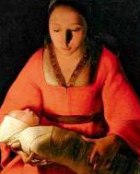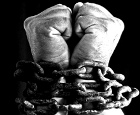Bible tribes, clans and families
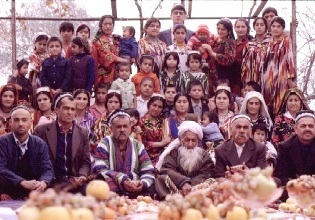
Family, work, worship:
there was safety in numbers
When the word ‘family’ is used in the Bible, it usually means either the clan or the extended family group, and includes not only parents, children, aunts, uncles, cousins, grandparents, etc., but also the people who worked with and for the group, and their families as well. A ‘family’ could very easily include as many as two hundred people, or as few as fifteen. The size of families meant they could provide enough labor and skills for a large number of people.
There were four family groups in ancient Israel:
- the tribe, which worked as a single unit when attacked by outsiders
- the clan, a group of extended families living in the same area and having common ancestors
-
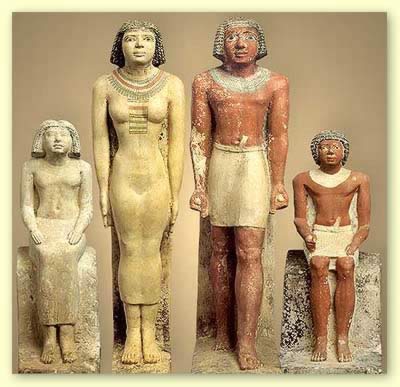
Family, Work, Worship: a family group in ancient Egypt. In reality, a family was much larger than this
the extended family with the same ancestor; they often lived in adjoining tents/houses and had rights and duties to other families in the clan (Leviticus 25:25, 47-49, Jeremiah 32:6-15)
- the nuclear family consisting of parents and unmarried children.
Because of its size and diversity, the clan only worked successfully if it worked in harmony. Individualism as we know it in the modern world did not exist. The rights and liberties of the individual, which we take for granted, would have worked against the unity that the clan needed to survive.
Ancient cultures were group-oriented. Women and men saw themselves not so much as individuals, but as members of a group, of their own family in particular. They did not think about what they themselves wanted, but what would be good for the group.
Women in the clan or family
There were two spheres of influence within the family: women’s, and men’s. The two groups listened to each other’s opinions, but maintained separate powers within their separate spheres. Ideally, neither group dominated the other.
The women’s sphere was the household and everything that related to it. A woman made the decisions within her household.
Women performed tasks together, gave each other support and help, and had their own stories, jokes and entertainment.
Within any ancient clan there was a central family, who gave the clan its name.
The matriarch was the woman within the central family with the highest social standing, and she received the greatest respect. She was responsible for the well-being of all the members of the clan, and was expected to oversee all the tasks mentioned in Proverbs 31 (see the section on ‘Women’s Work). She made the day-to-day rules for the clan and resolved disputes between women. The women of the central family shared in the status of the matriarch and supported her in her duties and responsibilities.
There were various grades of status, and married women might be wives or concubines. A concubine was a secondary wife, or a wife without dowry, and therefore of lower status than a wife. She had fewer legal rights than a wife who had brought bride-money into the family.
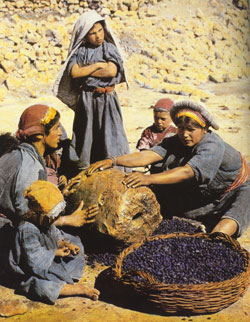
Women crushing olives
People attached to the family
Attached to this central family were its servants, female and male, and their families. Servants could be free-born or slaves:
- a free servant was paid in wages to perform specific tasks; free servants could be domestic servants or agricultural laborers
- a bond servant was contracted to work for a specific period of time
- a foreign slave had been captured in a war or a raid and was bought at market
- a ‘houseborn’ slave was born of a woman who was already a slave within the household
- a Jewish ‘debt’ slave was sold by her/his family to repay a debt; they were released on payment of the debt, during Jubilee Year (Leviticus 25:39-43, 47-55) or after six years of service (Exodus 21:2-4, Deuteronomy 15:12).
Slaves did many types of work. If they had ability and luck they might be physicians or accountants or business managers. Many slaves achieved wealth and high status; others were forced to work at less pleasant tasks, for example in mines or quarries.
There were strict laws about the treatment of slaves (Exodus 21, Genesis 17:12-12). Slavery was an entrenched part of the ancient world, but Jews believed that slaves ought to be treated well. Jews were always conscious of their past, and the way they had been harshly treated when they themselves were slaves in Egypt.
Note: It was an accepted practice to give servants and slaves as part of the dowry of a wealthy young woman. If Hagar was a gift from Pharaoh, she was probably an accomplished servant with valuable skills. Becoming the servant of a nomadic tribeswoman may have been a step down socially for her.
Hagar, slave of Sarah
For interesting case studies of three slaves who appear in the Bible, see Bible Slavery.
With all these varying types of people, the clan was diverse in its racial mix and its status levels. As well, it contained people of every age, from very old people to new-born babies.
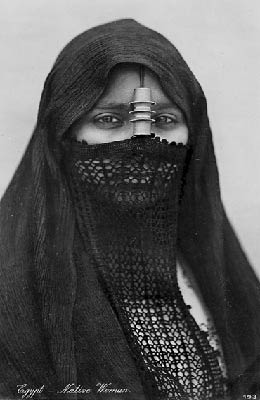 In the Bible, all the members of the clan/family were under the authority of the oldest male, and had to abide by his decisions. However, stories about women in the Bible show that, in practice, women often took the lead in decisions affecting the family and acted on their own initiative.
In the Bible, all the members of the clan/family were under the authority of the oldest male, and had to abide by his decisions. However, stories about women in the Bible show that, in practice, women often took the lead in decisions affecting the family and acted on their own initiative.
The stereotype of submissive women in historical times is not consistent with the women we read about in the Bible. A woman’s role depended, to a large extent, on the circumstances of her life and the strength of her own personality.
Jewish women had authority in the home, and this authority was built into the law. For example, when Sarah and Abraham argued about what should happen to Hagar and Ishmael, God told Abraham that he must do what Sarah told him to do: the senior woman of the clan had legal power over the women and children of her family.
Men and women were equally responsible before God and in law for their actions; for example, a man and a woman who were convicted of adultery both faced the death penalty (Leviticus 20:10).
Laws relating to food applied to woman and to men equally. The books of Deuteronomy and Numbers show that both women and men had the same moral responsibilities. Men had other obligations, such as making the annual pilgrimages, but women often accompanied their husbands on these journeys.
Activities
Who’s the boss?
Look at some of the social structures you encounter in your daily life, like your family, or your group of friends, neighbors, etc.
1. Who is in charge of the group?
2. Who has real authority? Who makes the decisions? Is it the person in charge, or is it another member of the group?
3. How is authority exercised in the group? Through respect, intimidation, affection?
4. How do the structures of these groups compare with the structure of the family/clan in biblical times?
Search Box
![]()
What tasks did a woman do?
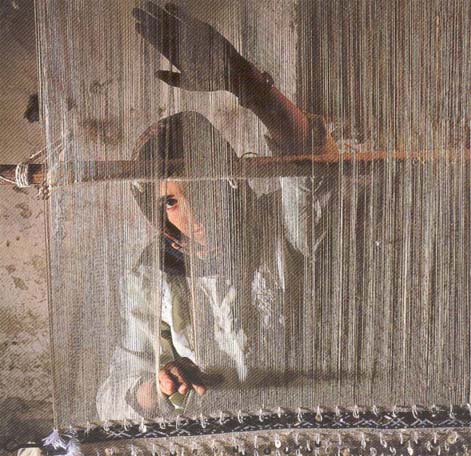
Women, work, worship: A Middle Eastern woman works at her loom
We tend to imagine ancient women confined to their looms and their kitchens, and these tasks of course occupied a large part of their time, but they also did many other forms of work.
You can get an idea of these tasks by reading Proverbs 31:10-31, a poem describing the ‘Woman of Worth’. Proverbs 31 lists all the attributes of an ideal woman, listing her goals and tasks. These included:
- finding a respected, learned and well-to-do man to be her husband
- spinning and weaving cloth, to make the family’s clothing and in the earlier period the tents they lived in
- making and selling finished items of clothing
- designing and making suitable clothing for all members of the household, for both winter and summer
- dressing herself well and attractively
- keeping herself physically and mentally strong and fit
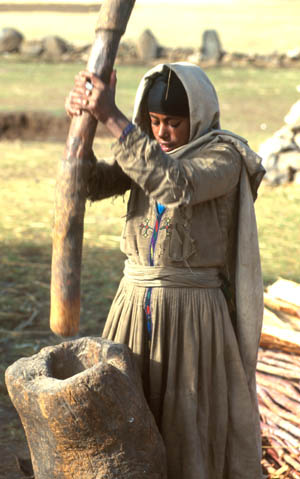
Women, work, worship: crushing grain
- giving religious instruction to her children: she was their first teacher
- gathering food and assembling a varied and healthy diet for the members of the household
- administering the finances of the family and overseeing the family business, with all the necessary skills
- buying investment property wisely
- supervising investments and making a profit from them, then re-investing the profits
- performing charitable work and caring for the poor
- organizing and supervising the tasks of all the servants in the household
- overseeing the emotional and physical well-being of all the members of the household
- being available at all times to anyone who needed her.
You will notice that the list hardly mentions children. This is not because children were unimportant, in fact quite the reverse. It was taken for granted that children were the central concern of a woman’s life. Children were the great blessing given by God, and not having children was counted as a very great misfortune. The household that a woman governed was centered on the maintenance of a healthy and happy extended family.
Activities
The Ideal Woman/Man
Read Proverbs 31:10-31. It describes the Woman of Worth and lists all the attributes of an ideal woman.
How many of the tasks are performed in one way or another by women today?
How many do you expect to perform during your own life?
Women & religion in the Bible
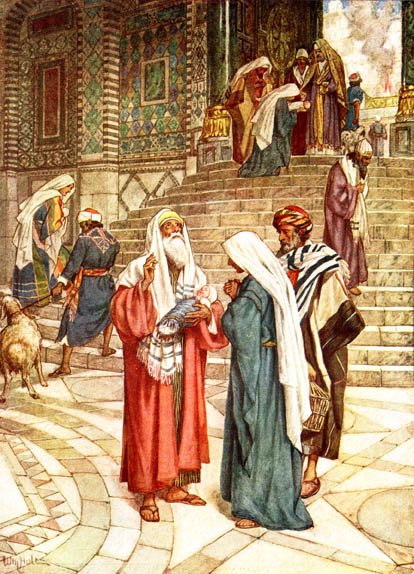
The Women’s Court in the Temple of Jerusalem
The Jews of the ancient world lived in a religious culture. Religion was completely integrated into their daily lives, so that everything they did, said, ate, thought and made had religious implications.
The laws that governed their lives were not state laws as ours are, but laws laid down by God.
Jewish law emphasized the equality of the sexes before God. The role that men played in worship in the outside world was counterbalanced by the leading role of the mother in worship and religious instruction within the home.
Women and the Passover Meal
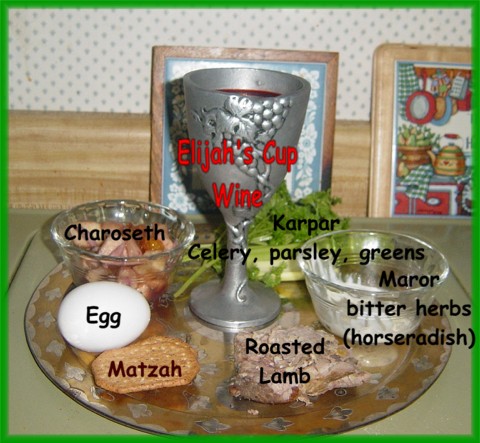
The Passover Meal
For example, a Jewish woman presided over the Passover meal, which commemorated the day the first-born sons of Jewish parents were spared from death when Moses freed the Jewish slaves in Egypt.
This moment in Jewish history established the identity of Israel, as a nation of free people.
At the same meal, Jewish parents were reminded that it was their responsibility to educate their children in the Jewish faith – the mother being the first educator of the children.
Jewish women were seen to be shapers of the Jewish future. This responsibility was appropriate because Jews have always seen women as more spiritual and open to religious ideas than men, and as closer to God.
Women were in charge of maintaining the ‘Jewishness’ of the family. Women
- presided over religious celebrations within the home
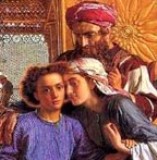
Detail of the Finding of Jesus in the Temple, William Holman Hunt
- supervised their children’s religious education
- were in charge of maintaining complicated food laws, essential for a good Jewish family
- prepared and supervised the frequent Jewish festivals.
Women could not be priests, but neither could most men, as priests came from certain families, and their role was hereditary.
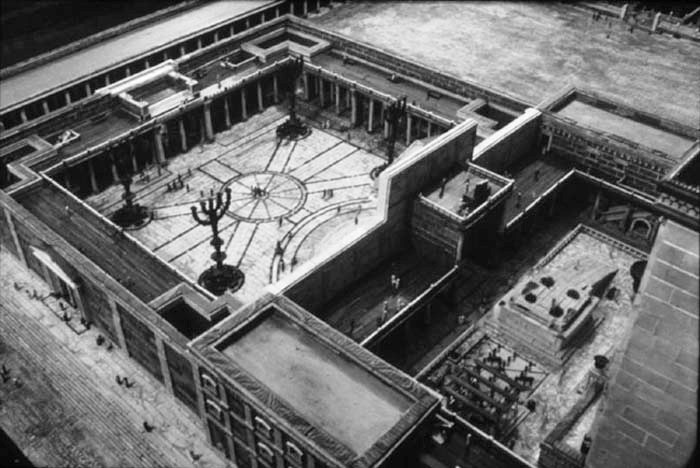
Reconstruction of the Women’s Court (upper left)
in the Temple of Jerusalem
Women in ancient religions
The dominant role that women played in religious leadership in the Jewish home may have come from the active role that women in ancient societies had in other religions, particularly the fertility religions.
It is now generally accepted that religion in Canaan from the 12th century BC onwards was based on the main agricultural festivals of the barley and wheat harvest of spring, and the fruit harvest of autumn.
Israelites worshipped at ancient local sanctuaries, and there was no centralized priesthood or system of sacrifice.
It was only later, through the work of the prophets, especially those of the 8th century BC (Hosea, Amos, Isaiah, Micah) and reforming kings of Judah such as Hezekiah and Josiah, that the organizations of religion as presented in the stories about the Patriarchs and Matriarchs actually began to emerge.
Woman represented the power and fertility of the female – in humans and Nature. All ancient religions had a goddess figure who embodied
- the power of a woman to generate life
- her role as fierce protectress of the family
- her duty to be a steadying influence or ‘wise woman’.’
In the agricultural religions, the forces of nature were often personified as goddesses with female qualities. The goddesses of nature were life-giving, maternal and protective. They defended their families and interacted with the clan of gods in much the same way that human women interacted with their own families. Some of them, like Anat the protectress of the family, could be quite terrifying and warlike, which seems to suggest that ordinary women were expected to be strong defenders of their own families.
It was natural that women served as priestesses in the worship of the goddesses in most of the ancient cultures. This happened for example
· in Canaan, in the worship of Asherah the earth-mother, and of Anat
· in Egypt, particularly in the worship of life-giving Isis
· in Greece, for goddesses such as Hera the queen of creation, Aphrodite the goddess of beauty and physical love, and Demeter the earth mother and source of fertility.
As far as ordinary people were concerned, the ancient gods were all around, a daily experience. They were not remote or invisible.
They were easy to identify with, since they reflected humanity. The gods and goddesses did all the things that people do. They had sex, got angry, fell in love, quarreled with their families, and generally expressed what was best and worst in human nature.
The worship of Asherah and Anat persisted in Israel, at least until the post-exilic period after 538BC (see the references in Judges 3:7, 1 Kings 15:13, 1 Kings 18:19, 2 Chronicles, 15:16, Jeremiah 44:15ff).

Carved image of
an ancient fertility goddess
Women continued to serve the natural forces representing fertility in humans and in Nature, even after the male priesthood forbade them to do so.
Until quite late in the biblical period, most families also had their household deities, similar to the lares and penates of the Romans (for an early example of this, see Rachel’s household gods in Genesis 31:19-35).
These household gods were personal spirits who guarded a particular home and the family who lived there.
Activities
A Woman’s Place?
1. What are the roles that women take in modern religion? Draw from your own experience of religious and community events and festivals, but try to include a range of religious denominations in your response.
2. Are you for or against an increased role for women in religious ceremonies?
3. Interview older people you know about the changes they have seen in the roles that women perform
- during religious worship
- in activities related to religious groups.
4. Ask them what they think of the changes they have seen in church worship and ceremony. Do you agree?
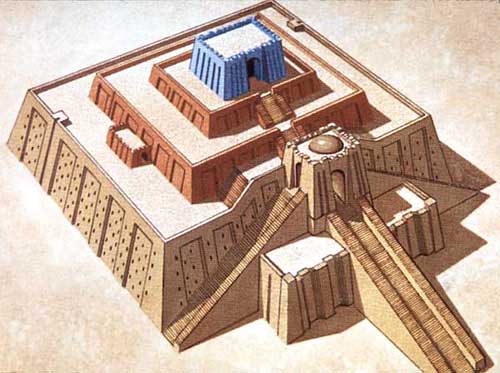
A reconstruction of the ziggurat at Ur,
the city Sarah came from
Search Box
![]()
Dozens of extra ideas at Activities for Bible Study Groups and Schools
Read about the fascinating women of the Bible
Women of the Bible: Family, Work, Religion, Bible Study Resource
Family, work, religion links
© Copyright 2006
Elizabeth Fletcher


